House of Dogs: The Last Squires of Trecwn Part 14 – Death and Rebirth
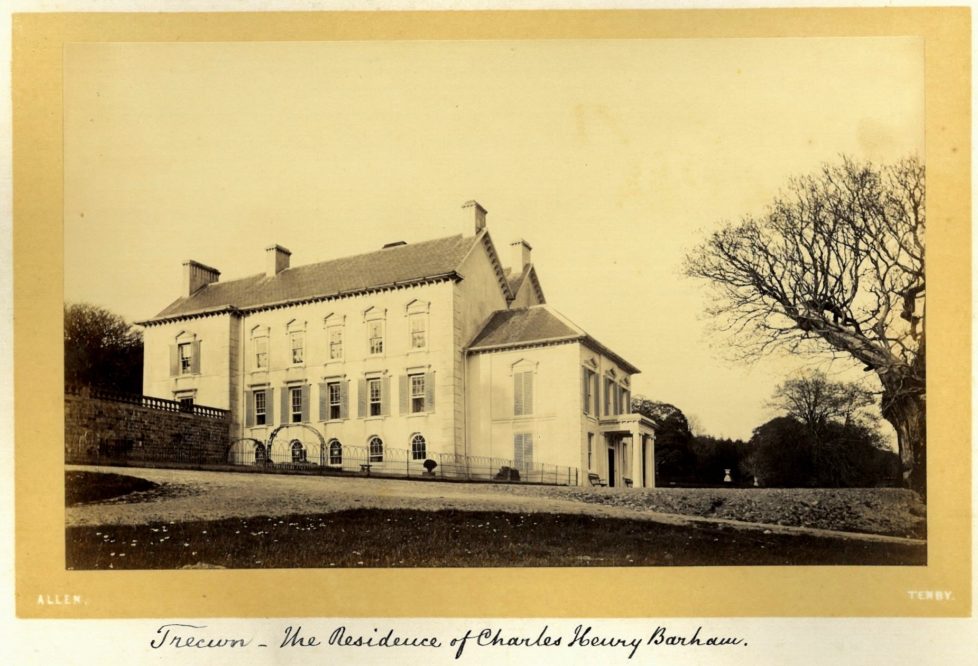
We continue our series exploring the history of a Pembrokeshire estate and its colourful family.
Howell Harris
Last Rites
The mansion and grounds at Trecwn were advertised as “to let” by the Barham estate’s administrators, Dorothy and her scholarly uncle Francis Hughesdon, within a few weeks of her family’s deaths — “electric light, telephone, shooting and fishing rights; some land, beautifully situated.” (Her younger sister, Jeanne, was only 14, so had no formal role or voice in their decisions.)
They quickly found a tenant: Guy Noott, a local businessman, owner-manager of two cinemas in Haverfordwest, and keen sportsman, who paid them £174 (the equivalent of about £42,000) a year. With him as ersatz squire things returned almost to normal.
He won Cyril’s old Henry’s Mote seat on the county council in 1934, and invited the Pembrokeshire Hunt back to chase and kill the foxes for three more seasons. But 1936 would be their last. Everything was about to change forever.
Rearmament to the Rescue
Pembrokeshire in the early 1930s was gripped by chronically high unemployment, particularly severe around Pembroke Dock which had lost its Royal Naval Dockyard and about 2,000 good jobs in 1926 and never recovered.
It was the “doomed town of the West” or “the town on the dole.”
The county as a whole lost population, from 92,000 before the Dockyard closed to a low point of about 83,000 between 1936 and 1939; Pembroke Borough (including the Dock) alone lost about 3,500 people between 1921 and 1931, and still had c. 1,500 unemployed men in 1934.
It was desperate for government investment and, thanks to its strategic position, with ready access to any future naval war in the Atlantic but far from the threat of enemy bombers (or so it was thought; the Luftwaffe would prove this forecast wrong), it began to hear hopeful news at the end of 1931.
The Admiralty announced their intention to establish a “storage depot” just east of Milford Haven at Newton Noyes, where there was already a railway connection to the Great Western, some flat land with a couple of factories on it, and a loading jetty.
But the progress of the project was very slow — site surveys in 1932, land acquisition, detailed planning, and some preparatory works in 1933-34.
Only in 1935 did construction begin for a large complex where naval mines would be filled, stored, maintained, and loaded onto minelayers for the defence of Britain.
In some ways the delay was beneficial, because the project grew significantly once the Admiralty determined that the jetty needed to be rebuilt and that surface storage of munitions was no longer acceptable (a wise re-evaluation of the Luftwaffe’s growing capabilities), so they decided that nine tunnel-magazines would be driven deep into the hillside instead.
The initial budget was c. £250,000. By 1935 that figure had already almost doubled, and it kept climbing, to £700,000 by 1938, the last public report, and probably further.
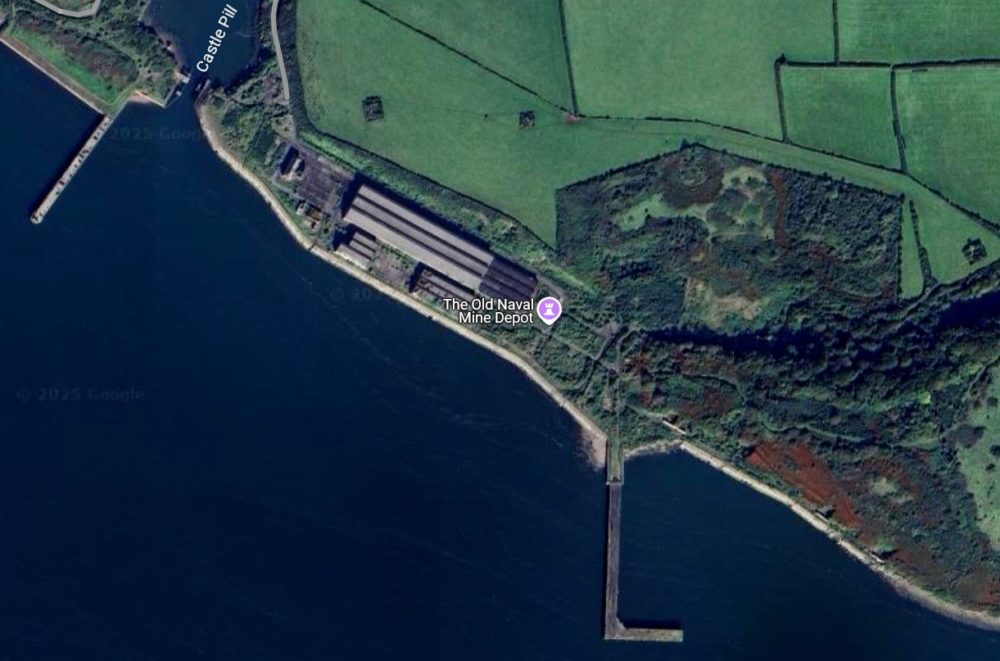
The Gods of War Come Back for More
Advocates for Pembroke Dock remained dissatisfied, because — apart from extensions to the RAF seaplane base established there in 1931 — the new construction jobs created by the mine depot and other major projects (notably underground fuel storage tanks) in Milford Haven were relatively inaccessible to its unemployed.
But in 1936 they had fresh hope: in March Ramsay MacDonald, Lord President of the Council in Stanley Baldwin’s cabinet, announced that there would be another government factory for South Wales. The site had been decided upon, but could not yet be revealed.
In August Baldwin himself raised hopes even further. Writing to the mayor of Pembroke, he promised more local investment — at least three flying boat squadrons, another air base nearby (Carew Cheriton), and “As regards the naval side of the question, the Government are well aware of the favourable situation of Pembroke strategically and its possibilities will be given the fullest consideration when any new naval establishments are contemplated.”
It was thus a huge disappointment when the Western Mail later that month began to report large land purchases in North Pembrokeshire, between Trecwn and Llanychaer, by an unknown bidder.
The buyer’s identity became clearer in September, when surveyors and work parties were reported to be laying out a new railway branch off the Great Western main line to Fishguard, going from Letterston in the direction of the Gwaun. Finally, at the end of October, the mask dropped.
A thousand acres of the Trecwn and Llanstinan estates plus a few smaller properties had been purchased by the Admiralty, Llanstinan’s only for the railway, construction of which began in December, Trecwn’s for the new project itself.
The Admiralty had in fact already agreed to buy 705 acres of the Trecwn estate by the time that MacDonald made his announcement, and negotiations with the Barham administrators must have begun months earlier than that.
But even if they had not been willing sellers, they would have had no option. The Admiralty could have proceeded by compulsion.
The strength of its position was demonstrated by a curious feature of the bargain between them. The Admiralty acquired title and possession before agreeing a price.
The Barhams asked for £26,316 for the mansion and its surrounding outbuildings, gardens, woodlands and park, altogether 97 acres, plus 196 acres of home farm and another 412 tenanted acres; the Admiralty offered much less; and more than two years later an arbitrator settled on £15,809 (60 percent of the asking price, just over 20 times the annual rental income).
By that time the Nootts and the ordinary farm families had long ago left or been evicted, and construction was well under way.
As for the Barhams, in May 1939 Dorothy did her best to cut the family’s last ties with the area after more than 400 years.
She placed all of the remaining farms, smallholdings, and cottages, 3,538 acres scattered across four parishes, on the market in one huge sale.
The whole of it only produced £1,900 in gross annual rental income, a third as much per acre as the valley farms that had been lost, because so much of it was marginal land. It took years before it was almost all finally sold.
The Depot
The heart was ripped out of Trecwn. Three miles of the valley would be the site of an immense new naval armament depot, with about 500 acres — the valley floor and sides — contained within a high security fence eight miles long, patrolled by armed Royal Marines and Navy police.
There was a 600 acre protective belt of farmland and woods around it, and, in due course, a two-and-a-half-mile quarantine zone beyond that, where civilian development would be prohibited for decades on grounds of safety in the event of a catastrophic explosion.
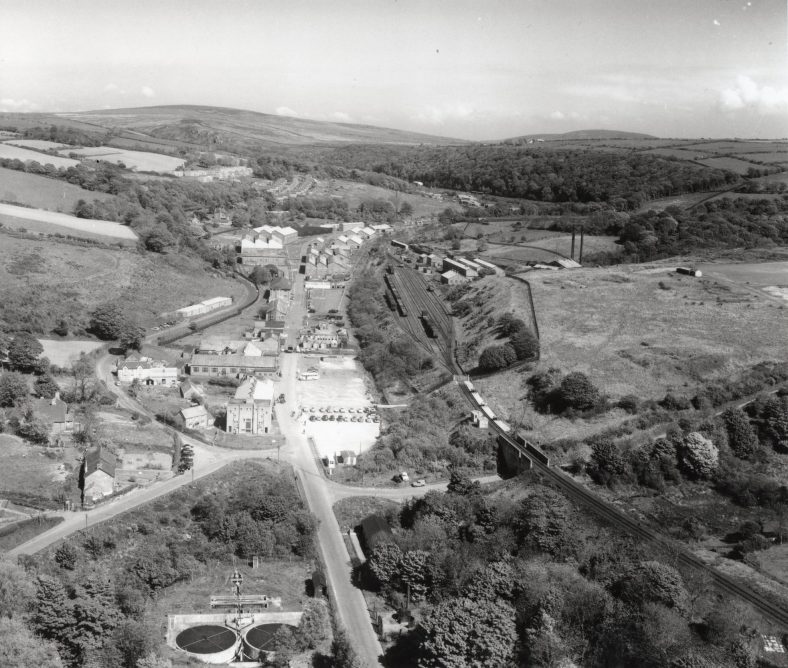
Only a few conservationists lamented its loss. Roy Saunders, secretary of the South Wales National Park Committee, campaigning for the creation of what would become the Pembrokeshire Coast and Brecon Beacons National Parks by the early 1950s, was appalled and depressed at the sacrifice of “one of Pembrokeshire’s greatest beauty spots” to “the gods of war.”
His colleague Lord Merthyr, addressing the House of Lords about the Army’s comparable desecration of the county he loved by taking 6,000 acres of the Stackpole Estate and a dozen miles of the finest coastline for a tank training range the following year, complained ironically.
“[T]he gentlemen who go round the country selecting sites for War Office and other military activities certainly have a way of picking upon beauty spots which is really almost uncanny. Their eye for scenery, their appreciation of landscapes, is impeccable.”
But to most of Pembrokeshire’s residents, to whom Trecwn, a private estate, was terra incognita, Admiralty, War Office, and Air Ministry investment meant jobs and progress.
Guy Noott, by then mayor-elect of Haverfordwest, spoke for them in November 1937. The project was bound to have a good effect. The county town would be “the natural shopping centre for the 2,000 workers who are to be engaged upon the scheme.”
The resulting growth in population and economic activity would result in more of the suburbanization and ribbon development that he also celebrated as signs of modernity, and the conservationists abhorred.
The following February the County Council did object most strenuously to the loss of Castlemartin, and sent a delegation to the War Office; but Pembroke’s mayor and council showed their and many locals’ understandable preference for jobs, however few, over landscape, however beautiful, by giving the proposal their public and active support — “We shall do all in our power to defeat the ends of the county council.”
They did not need to worry — the requirements of war preparedness overrode all other considerations, in the south of the county as much as in the north.
Pembroke celebrated. As the mayor argued, in terms that would become very familiar in later decades when the oil refineries came to what was by then supposed to be a National Park, “Pembrokeshire people cannot live on scenery.”
They had plenty and could do perfectly well with a bit less, and a few more jobs as compensation.
The Shape of Things to Come
At Trecwn a new road would be driven along the valley floor to the far end of the site. Beyond the terminus of the standard-gauge railroad branch there would be an extensive narrow-gauge railway system, partly laid on copper track to reduce the risk of explosions.
It ran right up the valley from the large industrial sheds built below the Barham School to the “red area” where there were 58 underground magazines hewn out of the rock, eleven semi-underground stores, and even a railway tunnel in which an entire loaded train could be parked safely overnight.
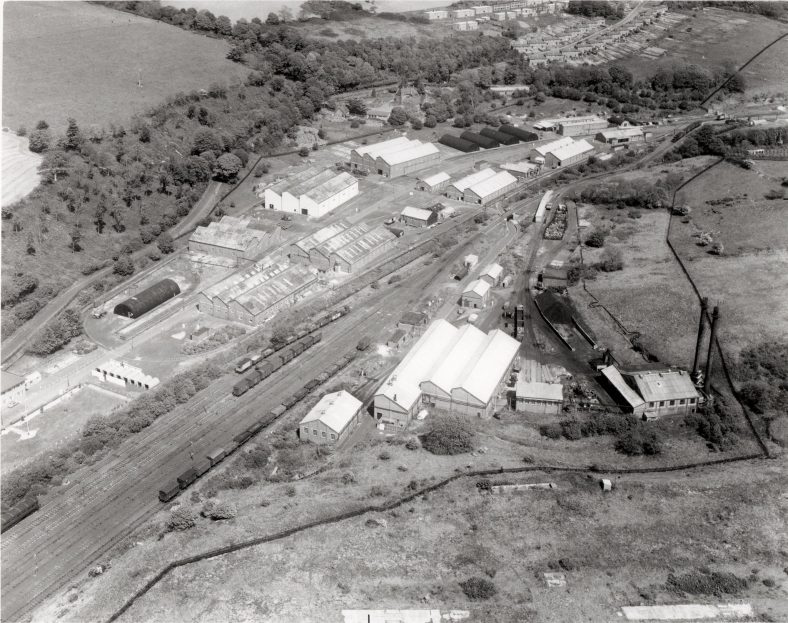
Digging and building the tunnels was the hardest and most costly part of the whole project — wet, filthy, and dangerous work.
There were 240,000 cubic metres of storage in the resulting magazines, and about 200 buildings occupying 300,000 square feet on the valley floor.
The valley itself was re-profiled, spoil excavated from the tunnels or quarried from the valley sides being used to raise and level it, so that buildings had to be set on piling foundations.
The Cyllell was canalised, the old wild trout stream and its otters soon no more than a fond memory.
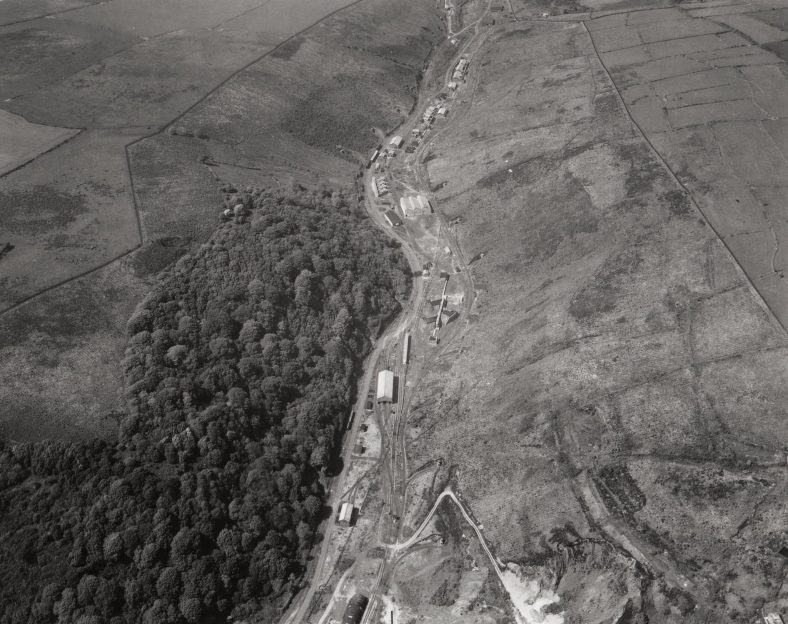
After the disturbance of the construction phase some fish did return, and the depot did have a basic treatment works for its sewage and other effluent discharges, but when they failed or were overwhelmed the Cyllell became a filthy drain, with fish-kill for miles until it met the still-clean Cleddau.
As for the Mansion, it was turned first of all into the headquarters of the large civil engineering and administrative staff required for this huge project, and then into a social club for its large workforce.
Trecwn was an isolated site — key to its suitability — but this meant that the Depot would have to be quite self-sufficient. It had its own water supply, electrical power and district heating plant, pub or club, and essential staff housing, stark and ugly red brick, some of which still remains.
In due course it even acquired, in the shape of Welfare Hall to the left of the main entrance, a theatre, cinema, and dance hall that made the Mansion redundant.
One unfortunate omission in the Admiralty’s programme of site preparation was that they do not seem to have photographed or produced measured drawings of the Mansion before they began to knock it about.
As they bulldozed its remains into its cellars when it burnt down after the war (allegedly the result of an accidental fire set by local boys trying to smoke a swarm of bees), we have no records of what we have lost.
They did allow an eminent archaeologist, Sir Cyril Fox, to photograph and draw the many vernacular buildings around the site — farm cottages a few centuries old — before they destroyed them too.
But he had no time for the Mansion and its surrounding buildings, “an estate developed in the English manner and providing little of antiquarian interest.”
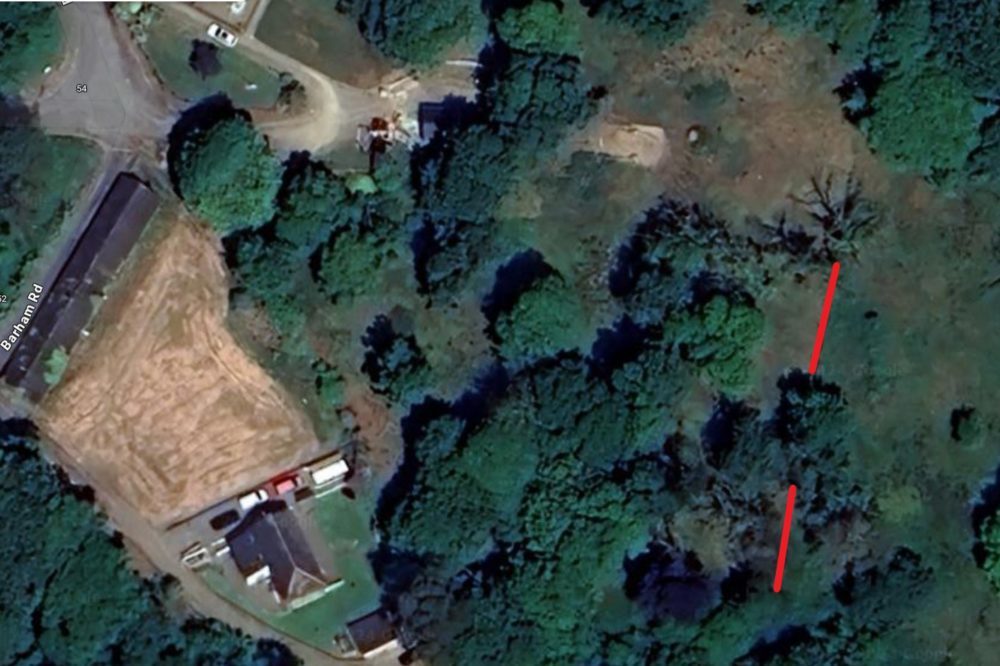
Trecwn dwarfed Newton Noyes in every way, including its budget. This started out as c. £3 million but grew steadily to somewhere north of £4 million — in modern terms, about £1.7 billion.
The purchase price of the land was a negligible proportion of this — about half the annual cost of travel subsidies for the depot’s scattered workforce.
The project was formally announced, with very little supporting detail, by the Civil Lord of the Admiralty in the Commons debate on the 1937 Navy Estimates.
Pembroke Dock’s disappointment was very public: the Council organized a mass protest meeting in response to the news, but there was nothing to be done.
Trecwn was built in the back of beyond for three obvious reasons: (1) isolation — security for the depot itself, and only a small surrounding civilian population to endanger; (2) railway transport access; and (3) geology — a narrow valley with rocky sides just inviting the driving of tunnels.
It would be difficult for the Luftwaffe to find and hit, even though Germany had good intelligence about the project from an early date. The bombers never got through.
Building such a large project in the middle of nowhere was obviously a challenge — not least assembling and housing the huge construction workforce, some of it locally recruited but much from further afield.
About a quarter were housed in temporary huts and hostels on the site itself, which even had a resident padre and a monthly magazine, the “Trecwn Times” or “Muck Movers’ Monthly,” like a military base.
But more employees lived or lodged in the small towns and villages for miles around, hence the travel subsidies.
The project’s economic effects thus rippled out across the county, the country (skilled underground labour was recruited from the mining districts of South Wales and as far away as Northumberland), and even the Irish Sea, where the Free State was a vital source of supply for hundreds of navvies.
Building Trecwn also helped get the quarries and brickworks of South Wales going full blast, but its revitalising impact on Pembroke Dock itself was quite small — the ex-dockyard unemployed were ten years older than when they had last worked, skilled men not attuned to the pick and shovel, and over twenty slow road miles and an undependable ferry ride away from North Pembrokeshire’s land of opportunity.
The Price of Progress
Despite the huge and immediate positive impact of the Trecwn project on the local economy — “‘All making money’ down Fishguard,” as a local paper reported in May 1937 — the way it developed meant that the initial welcome was quickly replaced by resentment that crystallised around a common loathing of the Irish.
In January 1938 Fishguard’s local council made a strong and unanimous protest against what it claimed was the undue preference for employment on the project being given to those “not domiciled in the commonwealth which provided the money.”
This hostility was sustained for more than a year.
When there was a typhoid outbreak in the St. David’s and Solva district in January 1938, and the first death was of a young engineer who worked at the site and lived in St. David’s, public opinion blamed Trecwn and its migrant workforce.
Dr. Howard Owen, still Medical Officer of Health for the Haverfordwest Rural District, had to not simply organise the response to the outbreak — containment, and extensive testing of water supplies and other potential sources — but counter demoralising fake news.
The District and the county council also had to appoint extra permanent staff to supervise and serve Trecwn and its vicinity.
So the Admiralty’s investment turned into a cost (local road improvements, extra council housing, education for hordes of incomers’ children, public health, policing) as well as a boon.
Fishguard remained the epicentre of anti-Irish sentiment. Hatred of outsiders was not confined to them: there was also “indignation” when, for example, a group of 50 men from Northumberland marched through the town on 18 January 1939.
But the Irish drew special fury, as “[a]lmost every other boat landing at Fishguard brings a contingent of them over and most of them are absorbed at Trecwn.”
To rub salt into the wounds of Fishguard’s 500 local unemployed, “[a]n official of one of the Government schemes in Pembroke told a Western Mail reporter ‘We must have good workmen here, and you cannot beat the Irish for this class of work.’”
The Irish did not just work hard, earn well, and look down on some of the local men — “They want lighter jobs” — they came into Fishguard to relax, and the results could be explosive:
With pockets full of money, many of the Irishmen get drunk in the town and do not hesitate to express their feelings against the Welsh, who will not stand for the insults.
As many as 100 men have been involved in street affrays.
The Irish taunt the Welsh with being no good for the type of work at Trecwn. … [N]ever before have such drunkenness and rowdiness been known in the town, and … the magistrates now send offenders to prison without the option of a fine.
Fishguard was unfamiliar with such scenes, including the energetic singing of Irish Republican songs in the street.
According to one county councillor, “During National Eisteddfod week, when there were 10,000 people from all parts of Wales here we did not have a single case of drunkenness or rowdyism,” thereby proving the Welshman’s moral as well as musical superiority.
The construction phase of the Trecwn project would not last forever, but what if any of the Irish stuck around? “[M]any of the importations across St. George’s Channel are likely to prove a permanent burden on the county rate.”
Even worse, they were undependable: when the War Scare came in 1938, before Munich, many “sturdy Irishmen” got back on the boats heading west as quickly as they had headed east for employment a few months earlier.
“Apparently armament work in this country had not the same attraction for them in a time of national emergency.”
They might even be potential terrorists, or at least sympathisers.
The mainland was gripped by an IRA bombing campaign in early 1939 and, as one correspondent, calling himself “Justice”, put it, “it would appear that the people of the Irish Free State are absolute enemies to our country, and dangerous ones at that; in other words, they do not hesitate to injure the people who feed them.”
There was some pushback, notably from the Rev. Dr. E.J. Kelly, parish priest in Fishguard, who offered a robust defence of his new congregation.
“It is an undeniable fact, maintained also by the police, that the vast majority of Irishmen who have recently come into the district are excellent and law-abiding men, of whom I am proud.”
He “resented the fact that Press notoriety seemed to be reserved for the few renegade Irishmen in drink.”
“In their sober senses, the insignificantly few degenerates are respectable citizens, too, but in drink they care for neither God nor man. As this type and the virtue of temperance cannot coincide, the cure lies in removing the cause.”
It was the responsibility of local licensees to not serve customers who were obviously drunk. As for the rioting, that was not the fault of the Irish but of the hundred or so local men who gathered in the town centre on Saturday nights, itching for a fight.
And then, almost as quickly as it had blown up in 1938, the anti-Irish sentiment calmed down by the spring of 1939.
With the gathering pace of rearmament and reemployment, it became less salient.
The government poured oil on troubled waters with dead-bat responses to demands from its own MPs and the press that something must be done — e.g. a registration scheme for the Irish, to end the “scandal” of their uncontrolled influx.
Perhaps the Irish even began to be appreciated as the vital resource that they were; but for that there is sadly no evidence.
What there is evidence for is something else, in the long run more significant.
The construction phase of the Trecwn project peaked in 1939-40 and alongside it a permanent, settled production workforce began to grow, more of it home-grown and bussed into the Depot from across the county.
Trecwn was turning from a construction camp into what it would be for the next fifty years — a new and diverse, but mostly local and increasingly Welsh, working community.
Even before wartime censorship drove Trecwn out of the papers, there were signs of things to come.
In October 1937 Trecwn, no longer a small, very Welsh agricultural hamlet, began to field a rugby team, travelling regularly to play matches around the county.
The Depot welcomed men from Pembroke and Pembroke Dock, if not necessarily as workers, then at least as visiting players.
There was soon a soccer team too. And even when their seasons ended, the conviviality didn’t.
The managers and employés at the works at Trecwn, Letterston, Pembrokeshire, together with their women folk, are now developing into a little social colony of their own, and there is an interchange of friendly feelings with the hospitable inhabitants of the neighbourhood.
Recently a team of local clergymen played a cricket match against the works employés.
The “gentlemen of the cloth” declared at 102 for seven wickets, and Trecwn were all out for 92. The finish was made the more remarkable by the fact that the last five men on the Trecwn side failed to score, and that the last wickets fell in the last over before time.
Next week the story of Trecwn will continue through the post-war years, embracing its closure in the early 1990s and the thirty years of dereliction and failed redevelopment plans that followed.
You can find the rest of this series here.
Support our Nation today
For the price of a cup of coffee a month you can help us create an independent, not-for-profit, national news service for the people of Wales, by the people of Wales.




